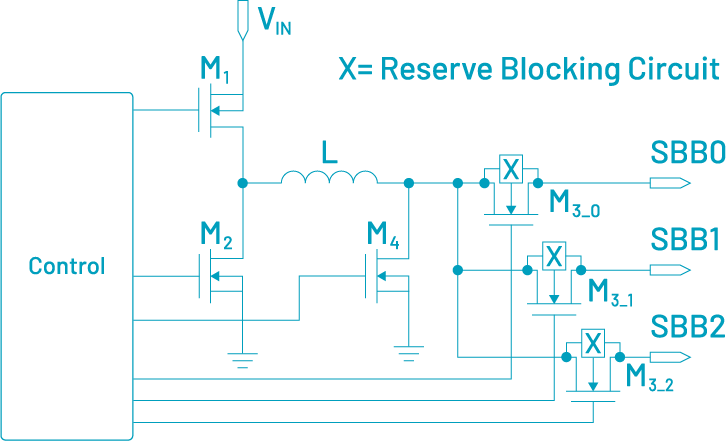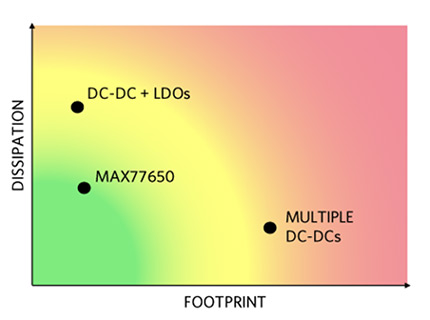SIMO Regulators
Ultra-Low Quiescent Current in Less Space
Additional integrated functionalities and features further simplify the design of low power portable devices by integrating functions such as battery management (charger and fuel gauging), LDO outputs for noise- sensitive rails, and on-board sequencer for controlled power-up and power-down. An I2C interface provides the capability to completely customize enables complete customization of the power management IC and supports dynamic voltage scaling (DVS) for additional power savings and custom power profiles.
SIMO Architecture
The SIMO architecture provides the best solution for tiny devices that require longer battery life. In a traditional switching-regulator topology, each switching regulator needs a separate inductor for each output. These inductors are large and costly, making them a disadvantage for smaller form factors. Linear regulators are fast, compact, and low noise, but they are lossy. Using a hybrid of multiple low-dropout regulators (LDOs) with DC-DC converters results in a larger design than using LDOs alone.
SIMO architecture enables integrated functionality in smaller devices that would otherwise require multiple discrete components. By reducing the number of required inductors while still maintaining switching converter efficiencies, a SIMO architecture represents a nearly ideal topology for smaller, ultra-low-power designs.

SIMO Benefits
Benefits of SIMO Architecture
Inductor Saturation Current
Inductor saturation current (ISAT) is the current where the inductance drops by a certain percentage and is determined by the inductor’s core size for a given core material and construction. By combining several inductors into one, there is a benefit to the total inductor sizing required. A SIMO provides benefits from:
- Improved cost savings and footprint.
- Quantification of available component values.
- Time multiplexing: If one system is off when another is on, they can "share" their required ISAT.
- Averaging: Even when there are not exclusive time slots, the current usage peaks often occur at different times. This results in a reduced ISAT requirement.
Power Dissipation
ADI’s SIMO converters offer an optimal tradeoff between footprint and dissipation. They are architected to provide the benefits of a DC-DC converter within the footprint of a single DC-DC, plus several integrated LDOs. Reducing the inductor count removes space between inductors, and this further contributes to the reduction of total footprint.

SIMO in PMICs
Our new power management ICs (PMICs), the MAX77650 and MAX77651, were designed with micropower SIMO buck-boost DC-DC converters. An integrated 150mA LDO in the PMICs provides ripple rejection for noise-sensitive applications. In the MAX77650/MAX77651, the SIMO provides three independently programmable power rails from a single inductor for an innovative power management solution. The high integration of SIMO architecture helps significantly reduce the overall solution size compared to other discrete solutions.
SIMO Calculator
As an added design tool, our SIMO calculator is available to help you explore the tradeoffs associated with SIMO parameters. On the calculator tab of this spreadsheet-based tool, you can enter the system parameters in the corresponding values cell within the top section of rows. The calculated values that are deemed the most interesting are highlighted in yellow. If a parameter is outside the normal region, the cell will be highlighted in red. The comments section provides guidance on ways to enhance your design.


